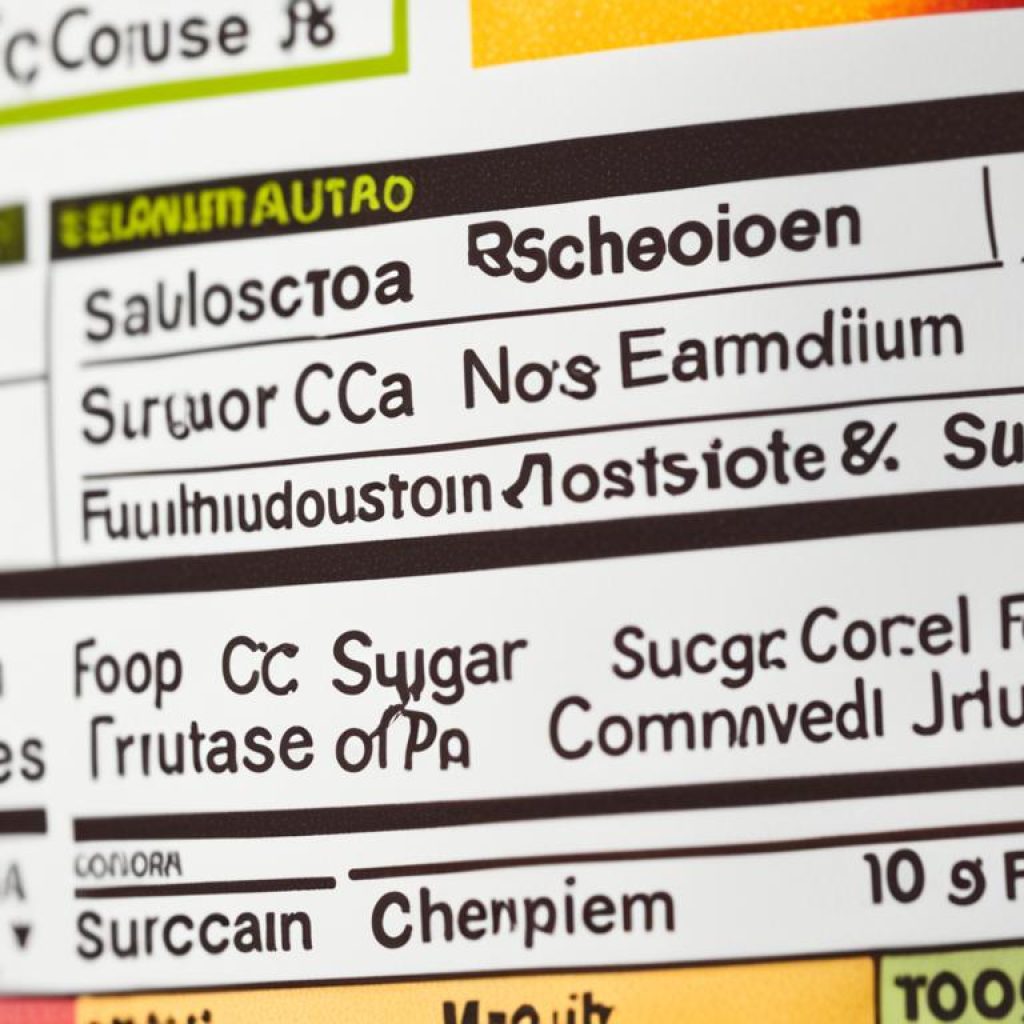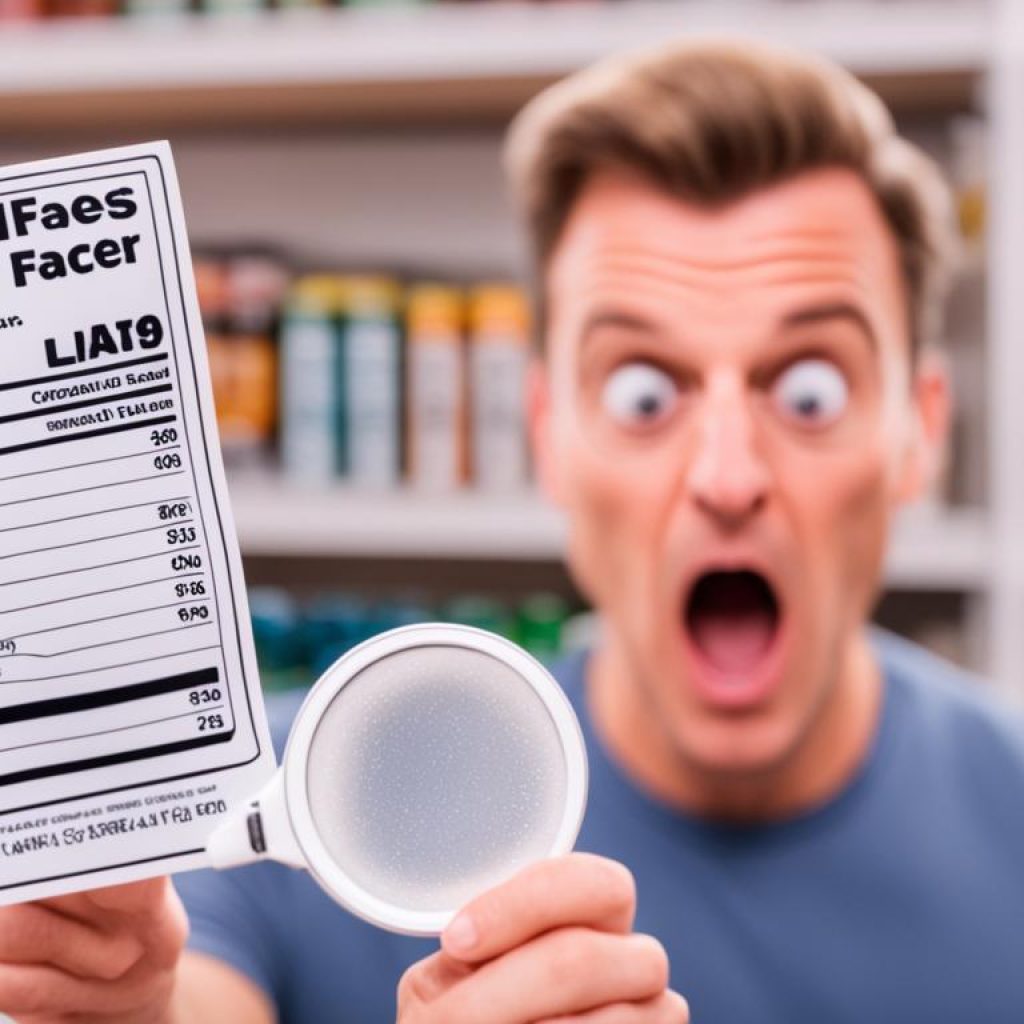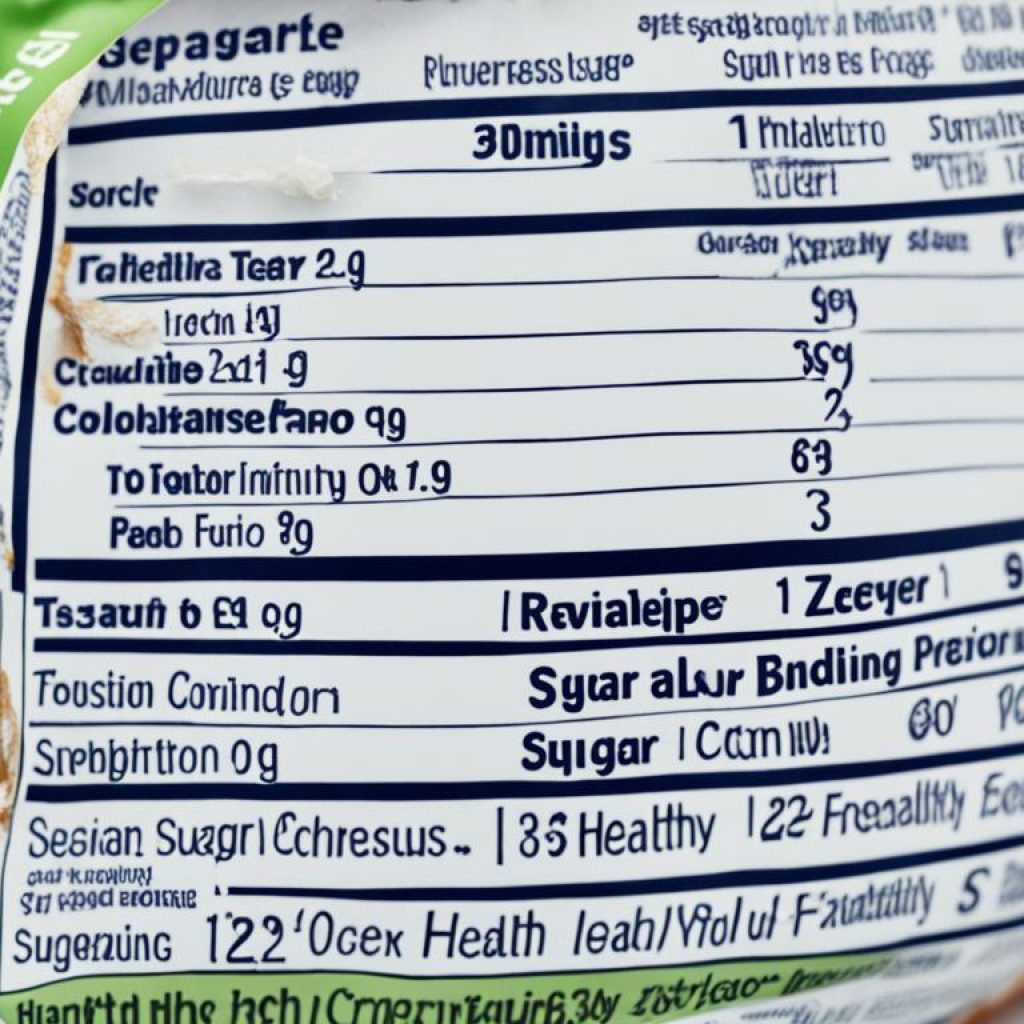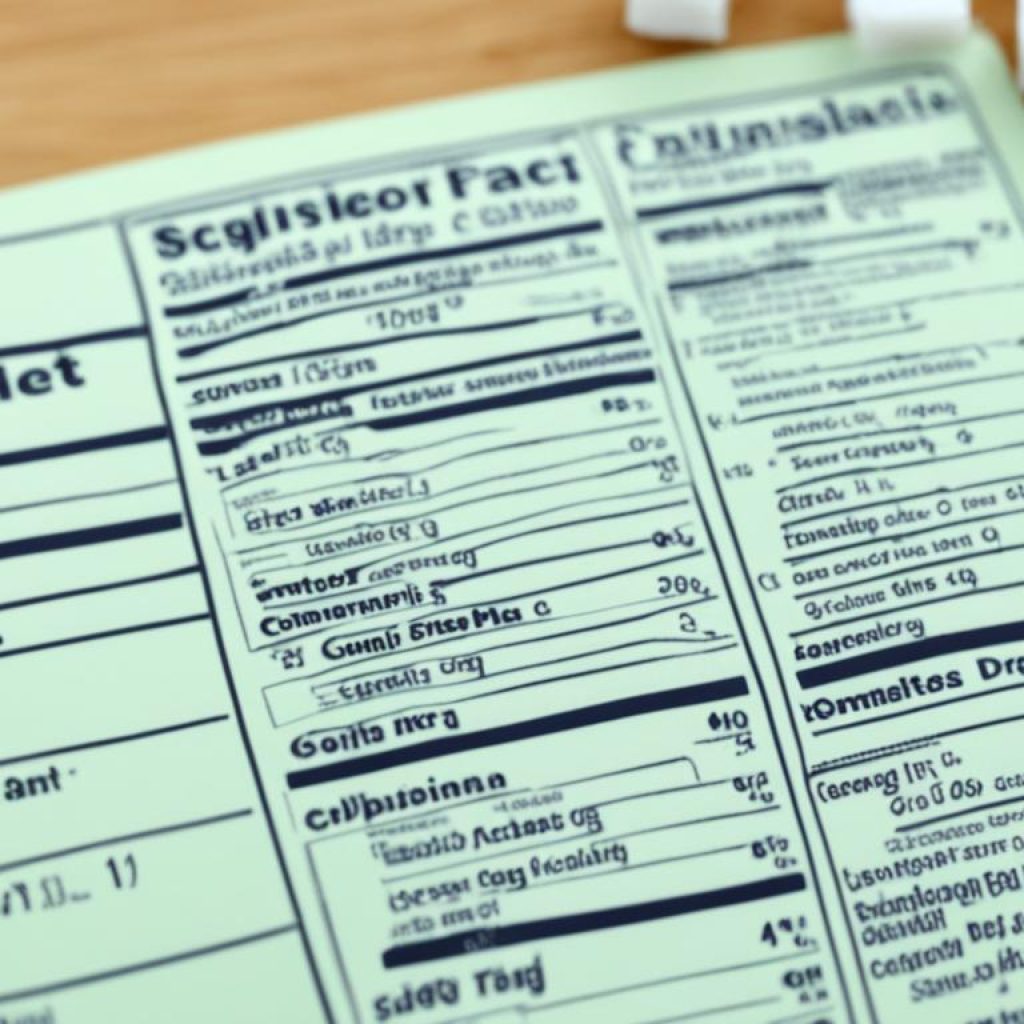Did you know that the average American consumes a staggering 22 teaspoons of added sugar per day? That’s equivalent to 88 grams or 352 calories! This excessive sugar intake puts our health at risk and increases the likelihood of weight gain, diabetes, and heart disease. It’s essential for us to understand the risks associated with hidden sugars and learn how to decode food labels to make informed choices about our sugar intake.
Key Takeaways:
- Reading food labels is crucial for identifying hidden sugars.
- Common sources of hidden sugars include high fructose corn syrup and fruit juice concentrates.
- Pay attention to the ingredient list, total sugars, and added sugars sections on food labels.
- Understand the role of serving size in determining sugar content.
- Be aware of common misconceptions about sugar-free and low-fat foods.
The Importance of Food Labels
Understanding sugar in food labels and deciphering hidden sugars in food labels is essential for making healthy choices. Food labels provide valuable information about the nutritional content of different foods, helping you identify hidden sugars in processed products. By law, all packaged foods in the US are required to have a label that includes details about the ingredients and nutritional content. This information is particularly beneficial when it comes to identifying hidden sugars and making adjustments to your diet.
When reading food labels, it’s important to pay attention to the following:
- The ingredient list: Look for common names of sugars, such as sucrose, glucose, and fructose, which indicate the presence of added sugars.
- The sugar content: Check the “Total Sugars” and “Added Sugars” sections on the nutrition facts label to understand how much sugar is in the product.
- The serving size: Be mindful of the recommended serving size to avoid inadvertently consuming excessive amounts of sugar.
Informed choices about your sugar intake start with understanding food labels. By developing the skill to decipher hidden sugars, you can make informed decisions and take control of your health.
Decoding food labels is a key step in managing your sugar consumption. It helps you become aware of the hidden sugars in various processed foods, allowing you to choose healthier alternatives and maintain a balanced diet.
Types of Hidden Sugars in Foods
When it comes to hidden sugars in foods, they can be found in a wide range of products, from sweet treats to savory items like processed meats and condiments. It’s important to be aware of these hidden sugars and how they can affect your overall sugar intake. By reading food labels carefully, you can identify and avoid these hidden sugars, making healthier choices for your diet.
Common Sources of Hidden Sugars:
- High fructose corn syrup
- Fruit juice concentrates
- Honey
These ingredients often go unnoticed but can significantly contribute to your daily sugar intake. By knowing what to look for on food labels, you can spot these hidden sugars and make informed decisions.
Honey: A Hidden Source of Sugar
Did you know that honey, often considered a natural sweetener, is actually a hidden source of sugar in many processed foods? While it may seem healthier than refined sugar, it still contains high amounts of fructose and glucose, making it an added sugar to watch out for.
Reading the ingredient list is crucial for identifying hidden sugars like honey. Pay attention to the placement of these ingredients on the list, as the higher they are, the more significant their concentration in the product.

Uncovering Fruit Juice Concentrates
Fruit juice concentrates may sound natural and healthy, but they are frequently used as hidden sugars in processed foods. These concentrates are produced by extracting the water from fruit juices, leaving behind a highly concentrated form of sugar.
When reading food labels, keep an eye out for fruit juice concentrates as they are a common source of hidden sugars. Be cautious and moderate your consumption of products containing this ingredient to maintain healthier sugar levels in your diet.
| Product | Ingredients | Sugar Content |
|---|---|---|
| Fruit-flavored yogurt | Cultured low-fat milk, sugar, fruit juice concentrate | 20g per serving |
| Fruit juice | Apple juice concentrate, water, natural flavors | 15g per serving |
| Granola bar | Oats, honey, sugar, fruit juice concentrate | 10g per bar |
Table: Examples of Foods with Hidden Sugars
Source: Adapted from The New York Times
By being knowledgeable about the different forms in which hidden sugars can appear, you can become a more informed consumer and make healthier choices for yourself and your family.
Identifying Added Sugars in Processed Foods
When it comes to hidden sugars in processed foods, understanding how to read food labels is crucial. By carefully examining the ingredient list and paying attention to certain key sections of the nutrition facts label, you can identify added sugars and make informed choices about the products you consume.
Reading the Ingredient List:
The first step in identifying added sugars is to read the ingredient list. Look for common aliases such as sucrose, glucose, and fructose. These are different forms of sugar that may be used in food products. Remember, the higher an ingredient is listed on the list, the higher the concentration of that ingredient in the product.
Checking the Total Sugars and Added Sugars Sections:
Next, focus on the “Total Sugars” and “Added Sugars” sections on the nutrition facts label. The “Total Sugars” section provides information about the total amount of sugar in the product, including both natural and added sugars. The “Added Sugars” section, on the other hand, specifically indicates the amount of sugar that has been added during processing.
By referring to these sections, you can get a clear idea of the sugar content in the food you are considering. It’s important to be mindful of the recommended daily limit for added sugars, which is 25 grams for women and 36 grams for men, as exceeding this limit can have negative health implications.
To better understand how to identify added sugars in processed foods, let’s take a look at the following table:
| Product | Ingredient List | Total Sugars (per serving) | Added Sugars (per serving) |
|---|---|---|---|
| Fruit Yogurt | Non-fat yogurt, strawberries, sugar, cornstarch | 15g | 10g |
| Granola Bar | Whole grain oats, honey, sugar, almond butter | 12g | 8g |
| Cereal | Whole grain oats, brown sugar, corn syrup, almond pieces | 10g | 6g |
This table illustrates three different processed foods and their respective sugar content. By analyzing the ingredient list, you can identify the added sugars used in each product. Additionally, the separate columns for “Total Sugars” and “Added Sugars” provide a clear distinction between the overall sugar content and the sugars that have been added during manufacturing.
Remember, being aware of the hidden sugars in processed foods is a crucial step towards making healthier choices for your diet. By diligently reading food labels and understanding the different forms of added sugars, you can take control of your sugar intake and prioritize your health.
Decoding Nutrition Facts on Food Labels
Understanding the nutrition facts panel on food labels is crucial for making informed choices about your diet. Although it may seem overwhelming at first glance, focusing on a few key elements can help you decipher the hidden sugars in food labels and better understand the nutritional content of the products you consume.
Pay Attention to Serving Size
The serving size listed on the food label is an important factor to consider when analyzing the nutritional content. It determines the amount of food the nutrition facts pertain to, including the sugar content. Be mindful of the serving size and adjust your portions accordingly to accurately calculate your sugar intake.
Check the % Daily Value (DV)
The % Daily Value (DV) is a reference point that indicates how much of a specific nutrient, such as sugar, is contained in one serving of the food. It is based on a 2,000-calorie daily diet. When it comes to sugar, aim for foods with a % DV of 5% or less to avoid excessive sugar consumption.
Examine the Ingredient List
The ingredient list provides valuable insight into the actual ingredients used in the product. It is important to read the list carefully and look out for words that indicate the presence of hidden sugars, such as “syrup,” “juice concentrate,” or words ending in “-ose.” The ingredient list is typically ordered by quantity, so the higher up a sugar source is on the list, the more of it the product contains.
Avoid These Sugary Ingredients
Here is a list of common ingredients that indicate the presence of hidden sugars:
- Sucrose
- Glucose
- Fructose
- High fructose corn syrup
- Fruit juice concentrates
- Dextrose
- Maltose
- Corn syrup
- Honey
- Molasses
- Agave nectar
By familiarizing yourself with these ingredients, you can successfully identify hidden sugars that may be present in your food products.
| Nutritional Information | % Daily Value (DV) |
|---|---|
| Sugar | 5g |
| Fat | 78g |
| Sodium | 2,300mg |
| Protein | 50g |
By paying attention to the serving size, % DV, and ingredient list, you can gain a better understanding of the sugar content and make informed choices about the food you consume. Remember, deciphering hidden sugars in food labels is a skill that empowers you to take control of your health.

The Role of Serving Size in Reading Food Labels
When it comes to understanding the sugar content of the foods you consume, serving size plays a significant role. The amount of sugar and other nutrients you are consuming depends on the serving size listed on food labels. It’s crucial to check this information and adjust your portions accordingly to maintain sugar awareness.
Many packaged foods contain multiple servings, and it’s easy to consume more than the recommended serving size without realizing it. This can lead to unknowingly consuming higher amounts of sugar than intended. Being mindful of serving sizes can help you navigate food labels for sugar awareness and make informed choices about your sugar intake.
| Foods | Serving Size | Total Sugar per Serving |
|---|---|---|
| Granola Bar | 1 bar (40g) | 12g |
| Yogurt | 1 container (150g) | 15g |
| Soda | 1 can (355ml) | 39g |
As shown in the table above, different foods have varying serving sizes and sugar content per serving. By referring to the serving size and total sugar per serving, you can compare different products and make more informed decisions to manage your sugar intake effectively.
It’s important to note that the serving size on food labels may not necessarily reflect the amount you typically consume. Adjust the nutritional information accordingly if you consume more or less than the suggested serving size.
https://www.youtube.com/watch?v=Mw0lJlY8G7w
Remember, understanding the role of serving size in reading food labels is an essential step towards sugar awareness. By paying attention to serving sizes and adjusting portions accordingly, you can navigate food labels more effectively and make healthier choices for your well-being.
Common Misconceptions about Sugar-Free and Low-Fat Foods
When it comes to maintaining a healthy diet, many people turn to foods labeled as “sugar-free” or “low-fat” in an attempt to make healthier choices. However, it’s important to note that these labels can be misleading, and these foods may still contain hidden sugars or unhealthy ingredients. Let’s take a closer look at some common misconceptions about sugar-free and low-fat foods.
Misconception 1: Sugar-Free Means Healthy
Foods labeled as “sugar-free” are often seen as a healthier alternative to their sugary counterparts. However, it’s crucial to understand that sugar-free doesn’t necessarily mean healthy.
Many sugar-free foods contain artificial sweeteners, such as aspartame or sucralose, which provide the sweetness without the added sugar. While these sweeteners may help reduce calorie intake, they can still contribute to health issues.
“Artificial sweeteners, despite being sugar-free, have been linked to weight gain, increased cravings for sweet foods, and even potential negative effects on gut health.” – Dr. Samantha Harper, nutrition expert
To make informed decisions about the foods you consume, always read the ingredient list and nutritional information on food labels, even if a product is labeled as sugar-free.
Misconception 2: Low-Fat Means No Added Sugar
Many people assume that low-fat foods are automatically free from added sugars. However, this is not always the case.
When food manufacturers reduce or remove fat from a product, they often add sugar or other unhealthy ingredients to compensate for the loss of flavor. Therefore, low-fat foods may still contain added sugars, making them less healthy than you might think.
It’s important to read the ingredient list carefully to identify any hidden sugars or unhealthy additives in low-fat foods. Pay attention to terms like fructose, dextrose, or maltose, as they indicate the presence of added sugars.
Making Informed Choices with Food Labels
Reading and understanding food labels is key to making informed choices about the foods you consume. By decoding food labels for sugar content, you can avoid falling for common misconceptions and ensure that you’re making healthier choices.
When it comes to sugar-free and low-fat foods, always remember to:
- Read the ingredient list to identify any hidden sugars or unhealthy additives.
- Check the nutritional information for the overall sugar content of the product.
- Consider the serving size to understand how much sugar you’ll actually be consuming.
By taking these steps, you can make better choices for your health and avoid hidden sugars in seemingly innocent food options.
Remember, food labels are there to help you make informed decisions. Don’t be fooled by misleading claims like “sugar-free” or “low-fat.” Take control of your health by deciphering food labels for sugar content and choosing whole, unprocessed foods whenever possible.
The Impact of Hidden Sugars on Your Health
Consuming excessive amounts of sugar can have serious consequences for your health. Not only does it contribute to weight gain, but it also increases the risk of developing chronic conditions such as diabetes and heart disease. That’s why it’s crucial to be aware of the hidden sugars in your diet and take steps to reduce your overall sugar consumption.
One of the key ways to monitor your sugar intake is by reading food labels. Food labels provide valuable information about the sugar content of packaged foods, helping you make informed choices about what you eat. By understanding how to read food labels for hidden sugar, you can take control of your health and make positive changes to your diet.
The Risks of Excessive Sugar Consumption
Excessive sugar consumption can lead to weight gain and obesity. When you consume sugary foods and beverages, your body converts the sugar into glucose, which is then either used for immediate energy or stored as fat. Over time, this can result in weight gain and an increased risk of obesity.
Moreover, a high sugar intake can wreak havoc on your blood sugar levels. Consuming too much sugar causes a spike in blood sugar, leading to an increase in insulin production. Over time, this can contribute to insulin resistance and may eventually lead to the development of type 2 diabetes.
Additionally, consuming excessive amounts of sugar has been linked to an increased risk of heart disease. A diet high in added sugars can cause elevated triglyceride levels, increased blood pressure, and inflammation, all of which are risk factors for heart disease.
By understanding the impact of hidden sugars on your health, you can take proactive steps to reduce your sugar consumption and mitigate these risks.
“Excessive sugar consumption can lead to weight gain, increased risk of diabetes and heart disease.”
Tips for Reading Food Labels for Hidden Sugar
When it comes to reading food labels for hidden sugar, there are several key tips to keep in mind:
- Check the ingredient list: Look for common aliases of sugar, such as sucrose, glucose, fructose, and high fructose corn syrup. Be aware that added sugars can often be found under different names in the ingredient list.
- Pay attention to the “Total Sugars” and “Added Sugars” sections: The “Total Sugars” section includes both natural and added sugars, while the “Added Sugars” section specifies the amount of sugar that has been added during processing.
- Compare different brands: When choosing between similar products, compare the sugar content to make a more informed choice. Opt for brands with lower sugar content.
By implementing these tips and consistently reading food labels, you can gain a better understanding of the hidden sugars in your diet and make healthier choices.
The Impact of Hidden Sugars Image

Alternatives to Processed Foods with Hidden Sugars
When it comes to reducing your hidden sugar intake, opting for whole, unprocessed foods is a smart choice. These alternatives provide essential nutrients while helping you avoid the excessive sugar content often found in processed foods. Here are some options to consider:
- Fresh fruits and vegetables: Incorporating a variety of colorful fruits and vegetables into your diet not only adds natural sweetness but also provides essential vitamins, minerals, and fiber. They are a refreshing and healthy alternative to sugar-laden snacks and desserts.
- Lean proteins: Include lean proteins such as skinless chicken, turkey, fish, tofu, and legumes in your meals. They provide sustenance and help stabilize blood sugar levels, reducing cravings for sweets.
- Whole grains: Choose whole grains like quinoa, brown rice, oats, and whole wheat bread instead of refined grains. These nutrient-rich options provide a good source of fiber and energy while minimizing the hidden sugars commonly found in processed grain products.
By cooking meals from scratch, you have control over the ingredients and can avoid hidden sugars present in processed foods. This allows you to create delicious and nutritious meals tailored to your taste and health goals.
Remember, embracing these healthier alternatives to processed foods not only reduces your hidden sugar intake but also contributes to overall well-being, helping you maintain a balanced and nutritious diet.

Conclusion
Understanding how to read food labels for hidden sugars is essential for maintaining a healthy diet. By becoming familiar with the ingredient list, sugar content, serving size, and nutritional information provided on food labels, you can make informed choices about the foods you consume.
By actively decoding food labels for sugar content, you can identify hidden sugars in processed foods, such as high fructose corn syrup and fruit juice concentrates. Pay attention to common aliases for added sugars, such as sucrose, glucose, and fructose, which may appear on the ingredient list.
Remember that foods labeled as “sugar-free” or “low-fat” may still contain hidden sugars, so it’s important to read the ingredient list thoroughly. Choosing whole, unprocessed foods like fresh fruits and vegetables, lean proteins, and whole grains is an excellent way to reduce your hidden sugar intake.
Take control of your health by carefully reading and understanding food labels. By applying the tips for reading food labels for sugar, you can make conscious decisions about your diet and work towards maintaining a balanced and healthy lifestyle.
FAQ
Why is it important to read food labels?
Reading food labels is essential because it helps you identify hidden sugars in processed foods and make informed choices about what you eat. It allows you to understand the nutritional content of different foods and adjust your diet accordingly.
What are some common sources of hidden sugars in processed foods?
Some common sources of hidden sugars in processed foods include high fructose corn syrup, fruit juice concentrates, and honey. It’s important to be aware of these ingredients and read the ingredient list carefully to identify hidden sugars.
How can I identify added sugars in processed foods?
To identify added sugars in processed foods, it’s essential to read the ingredient list and look for common aliases such as sucrose, glucose, and fructose. Pay attention to the “Total Sugars” and “Added Sugars” sections on the nutrition facts label for detailed information about the sugar content.
What should I pay attention to when reading nutrition facts on food labels?
Pay attention to the serving size, % Daily Value (DV) for each nutrient, and the ingredient list. The serving size determines the nutritional content per serving, the % DV helps you select foods high in beneficial nutrients, and the ingredient list provides insight into the actual ingredients used in the product.
Why is serving size important in reading food labels?
Serving size plays a significant role as it determines the amount of sugar and other nutrients you are consuming. Always check the serving size listed on food labels and adjust your portions accordingly to avoid consuming more sugar than you realize.
Are foods labeled as “sugar-free” or “low-fat” always healthy choices?
No, foods labeled as “sugar-free” may contain artificial sweeteners, which can still contribute to health issues. “Low-fat” foods may contain added sugar or unhealthy ingredients to compensate for the reduced fat content. Always read the ingredient list and nutritional information to make informed decisions about the foods you consume.
What are the negative impacts of consuming excessive sugar?
Consuming excessive amounts of sugar can lead to weight gain, increased risk of diabetes, and heart disease. It’s important to understand and monitor your sugar intake to protect your long-term health.
What are some alternatives to processed foods with hidden sugars?
Choosing whole, unprocessed foods such as fresh fruits and vegetables, lean proteins, and whole grains can significantly reduce your hidden sugar intake. By cooking meals from scratch, you can control the ingredients and avoid hidden sugars in processed foods.
How can reading food labels help me make better dietary choices?
Reading and understanding food labels allows you to make informed choices about your diet. By learning how to identify hidden sugars in food labels, you can adjust your diet for better health and maintain a balanced and healthy lifestyle.
Leave a Reply